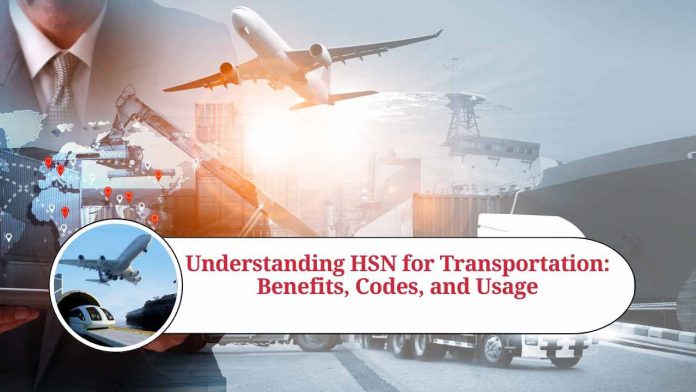Understanding HSN for Transportation: A Comprehensive Guide
HSN or Harmonized System of Nomenclature is an internationally recognized system for classifying goods. It is a multi-purpose system that serves various purposes, including customs tariffs, statistical purposes, and transport documentation. In the transportation industry, HSN plays a crucial role in facilitating the movement of goods across borders. In this blog post, we will provide a comprehensive guide on HSN for transportation, covering its basics, importance, and how it is used.
What is HSN?
HSN is a standardized system for classifying goods based on their nature, composition, and purpose. It is used to assign a unique code to each product that helps identify and track it throughout its journey from manufacturing to consumption. HSN is used globally and is maintained by the World Customs Organization (WCO).
Why is HSN important in transportation?
HSN plays a vital role in transportation by ensuring that goods are classified and described accurately. This helps prevent delays and errors at border crossings and ensures that the correct customs duties are applied. It also facilitates the collection and analysis of data on international trade, which helps policymakers make informed decisions.
How is HSN used in transportation?
HSN is used in various ways in transportation, including:
- Customs clearance: HSN codes are used to determine the customs duties applicable to goods crossing borders. The codes help identify the nature and composition of the goods, which in turn determines the customs duty rate.
- Transport documentation: HSN codes are included in transport documents such as bills of lading and commercial invoices. This helps identify the goods being transported and ensures that they are described accurately.
- Statistical purposes: HSN codes are used to collect and analyze data on international trade. This data is used to monitor trade flows, identify trends and patterns, and inform policy decisions.
- Supply chain management: HSN codes are used in supply chain management to track the movement of goods from manufacturing to consumption. This helps ensure that goods are delivered to the right place at the right time.
HSN codes for transportation
HSN codes for transportation cover a wide range of goods, including vehicles, parts and accessories, and transport services. Some of the most commonly used HSN codes for transportation include:
- Vehicles: HSN codes for vehicles include cars, trucks, buses, and motorcycles. Each type of vehicle has a unique HSN code based on its nature, composition, and purpose.
- Parts and accessories: HSN codes for parts and accessories include engines, tires, brakes, and electrical systems. These codes are used to classify the parts and accessories based on their function and composition.
- Transport services: HSN codes for transport services include freight forwarding, warehousing, and cargo handling. These codes are used to classify the services based on their nature and purpose.
Advantages of HSN in transportation
HSN provides several advantages in transportation. One of the primary benefits is that it simplifies the classification of goods, making it easier for customs officials to determine the appropriate customs duties. HSN also provides a standard framework for describing goods, which helps prevent errors and misunderstandings in international trade.
Another advantage of HSN is that it promotes transparency in international trade. By using a standard system for classifying goods, it becomes easier to track trade flows and identify patterns and trends. This information can be used to monitor the performance of individual sectors and countries, as well as inform policy decisions related to trade.
HSN also helps promote consistency in trade documentation. By including HSN codes in transport documents such as bills of lading and commercial invoices, it becomes easier to identify the goods being transported and ensure that they are described accurately. This helps prevent errors and delays in the transportation process.
HSN codes for specific modes of transportation
In addition to general HSN codes, there are also specific codes for certain modes of transportation. For example, the International Air Transport Association (IATA) has developed its own coding system for air cargo. The IATA cargo codes are used to identify and track air cargo shipments, and they are recognized by airlines, freight forwarders, and other industry stakeholders.
Similarly, the International Maritime Organization (IMO) has developed its own coding system for maritime transportation. The IMO shipping codes are used to identify and track ships, as well as the cargo they are carrying. These codes are used by port authorities, customs officials, and other industry stakeholders to ensure the smooth and efficient movement of goods by sea.
Conclusion
HSN is a vital system for classifying goods in transportation. It provides a standard framework for describing and tracking goods, which helps prevent errors and delays in international trade. HSN codes are used in customs clearance, transport documentation, statistical purposes, and supply chain management. By using HSN, stakeholders in the transportation industry can ensure the smooth and efficient movement of goods across borders, promoting economic growth and development.
Read more useful content:
Frequently Asked Questions (FAQs)
What is HSN?
HSN stands for Harmonized System of Nomenclature. It is an internationally recognized system for classifying goods based on their nature, composition, and purpose.
Who maintains the HSN system?
The HSN system is maintained by the World Customs Organization (WCO).
Why is HSN important in transportation?
HSN is important in transportation because it helps ensure that goods are classified and described accurately. This helps prevent delays and errors at border crossings and ensures that the correct customs duties are applied.
How are HSN codes used in customs clearance?
HSN codes are used to determine the customs duties applicable to goods crossing borders. The codes help identify the nature and composition of the goods, which in turn determines the customs duty rate.
How are HSN codes used in transport documentation?
HSN codes are included in transport documents such as bills of lading and commercial invoices. This helps identify the goods being transported and ensures that they are described accurately.
What are some common HSN codes for transportation?
Common HSN codes for transportation include codes for vehicles, parts and accessories, and transport services.
What are IATA cargo codes?
IATA cargo codes are a specific coding system developed by the International Air Transport Association (IATA) for air cargo. These codes are used to identify and track air cargo shipments.
What are IMO shipping codes?
IMO shipping codes are a specific coding system developed by the International Maritime Organization (IMO) for maritime transportation. These codes are used to identify and track ships and the cargo they are carrying.
Can HSN codes be used for domestic transportation?
Yes, HSN codes can be used for domestic transportation, although they are primarily used for international trade.
How can I find the correct HSN code for my product?
The WCO maintains a searchable database of HSN codes on its website. You can also consult with customs officials or industry experts to determine the correct code for your product.




















